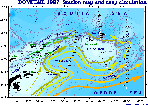|
Dovetail
Deep Ocean Ventilation Through Antarctic Intermediate
 DOVETAIL is an international
oceanography research program designed to observe physical processes
in the Weddell-Scotia Confluence region in order to quantify the
ways in which it influences ventilation of the World Ocean by
Weddell Sea water. DOVETAIL is an international
oceanography research program designed to observe physical processes
in the Weddell-Scotia Confluence region in order to quantify the
ways in which it influences ventilation of the World Ocean by
Weddell Sea water.
The US observation program began in late July 1997 with
a 40 day cruise on board the RVIB
Nathaniel B Palmer, during which CTD/tracer transects were
carried out, and current meter moorings and drifting ice buoys
were deployed. See the Cruise Report
for details. The moorings deployed on this cruise will join several
moorings put out earlier by investigators of the Alfred
Wegener Institute in 1996.
DOVETAIL priorities parallel, and the results will
contribute to, ongoing global change research. The processes responsible
for vertical and horizontal fluxes within the ocean and associated
interaction with the sea ice and atmosphere in polar regions must
be properly represented in global circulation and climate models.
The DOVETAIL study
region, off the tip of the Antarctic Peninsula serves as the
primary gateway between the southern polar waters and the global
ocean. This region can therefore be considered as a "vital"
location for long term monitoring of the discharge of cold Antarctic
Water into the global ocean. Results from the DOVETAIL
experiment will aid in establishing long-range monitoring of this
critical region. Both the Global Ocean Observing System (GOOS)
and the ocean component of the Global Climate Observation System
(GCOS)
have been established by a number of international bodies to provide
such monitoring data.
DOVETAIL is a component of the International
Antarctic Zone (iAnzone) program.
The US research in DOVETAIL is funded by the Office
of Polar Programs of the National
Science Foundation
|










